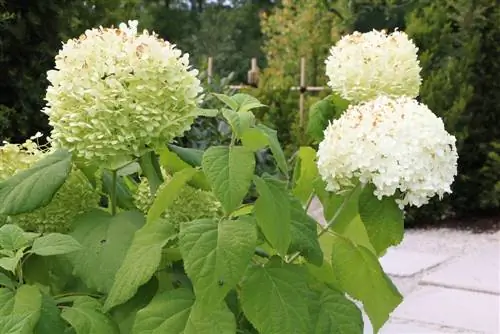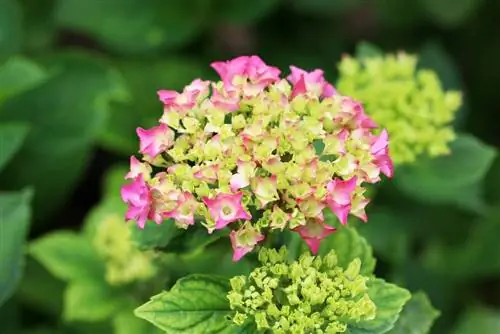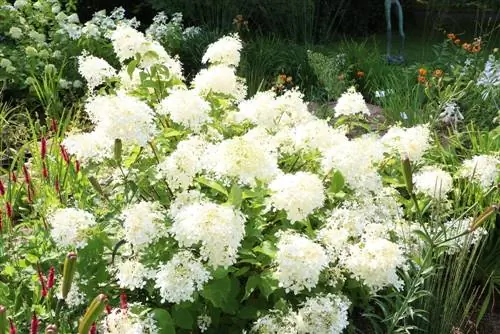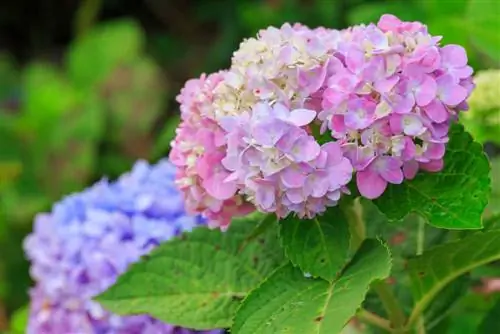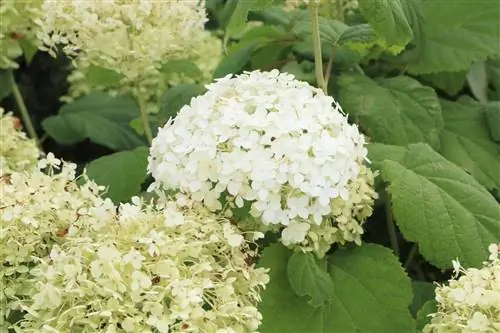- Author admin [email protected].
- Public 2023-12-17 03:39.
- Last modified 2025-01-24 12:45.
The snowball hydrangea is a real feast for the eyes in the home garden and is very popular. And rightly so, because the Annabelle hydrangea blooms from the end of June to September and decorates the garden with its large, white flowers. However, their floral splendor can only be seen if they are cared for professionally. Because both the optimal location and the care measures are essential for flower formation.
Location
The snowball hydrangea is also known as a forest hydrangea because it grows in open forest areas in the wild. If the quickball hydrangea is grown in the home garden, you should look for a location that is as partially shaded as possible. A location that is either too shady or too sunny is not good for the decorative plant: too much sun shortens the flowering period and can cause sunburn on the existing flowers. However, if it is too shady for the snowball hydrangea, flower formation will be delayed. A partially shaded spot with sun in the morning and evening is therefore ideal for them. When choosing a location, the following should also be taken into account:
- protected from the wind if possible
- leave sufficient planting distance
- as a hedge: about 35-85 cm distance
- in the group: 80-150 cm distance
Neighbors
Snowball hydrangeas are particularly good in areas with little vegetation under trees. Here the hydrangea not only comes into its own particularly well, but can also benefit from the tree: it not only provides the decorative plant with shade, but also protects it in heavy rain by softening the precipitation. The natural protection from rain is an advantage for the hydrangea, because heavy rain causes the flowers to grow larger, which could cause the flower stalks to bend. However, the hydrangea does not necessarily have to be planted next to a tree. In a place protected from the rain, it also harmonizes very well with large-leaved ornamental perennials and various ferns:
- Monkshood
- Ball Thistle
- Funkia
- Lupien
- Daylilies
- Boxwood
- Japanese dwarf spars
- dark-leaved Japanese maples
Soil / Substrate
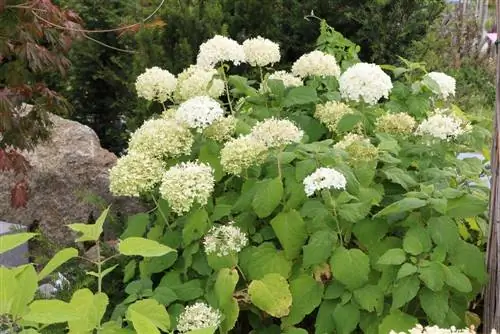
The Annabelle hydrangea thrives best in soil that has the same properties as a typical forest floor. This contains around 5 to 10 percent humus and around 50 percent mineral soil particles, which are created by the weathering of rock. The viburnum hydrangea benefits in particular from the humus substances, because these ensure that the air and water in the soil are penetrated. This promotes plant growth because it binds moisture in the soil and makes more nutrients available. The snowball hydrangea also thrives best when the soil meets the following requirements:
- humus-rich and loose
- sufficiently moist
- pH value neutral to acidic
- optimal is a pH value of 5.5-6.0
- lowest possible lime content
If the viburnum hydrangea is grown in a pot, it should preferably be placed in a mixture of rhododendron soil with humus-rich soil. Alternatively, bog soil is also suitable.
Planting
The Annabelle hydrangea is considered to be completely hardy, which is why it does not necessarily have to be planted in spring. Although the planting period extends throughout the year, the best time to plant is early spring. This means that the experienced hobby gardener can enjoy the decorative flowers in the first year. Before the viburnum hydrangea is planted, it is advisable to first prepare the soil thoroughly and improve it if necessary. If necessary, sand or leaf humus, for example, can be worked into the soil. When planting, it is best to proceed as follows:
- Dig up planting hole
- this should be about twice the size of the planter
- Dip the root ball in water for around 10 minutes
- This causes the earth to soak up water and store it
- Insert plant carefully
- cover with soil
- then pour well
Tip:
If the snowball hydrangea is cultivated in a bucket, drainage should definitely be created in the bucket. To do this, gravel or grit is laid out on the bottom of the bucket so that the excess water can drain away.
Support
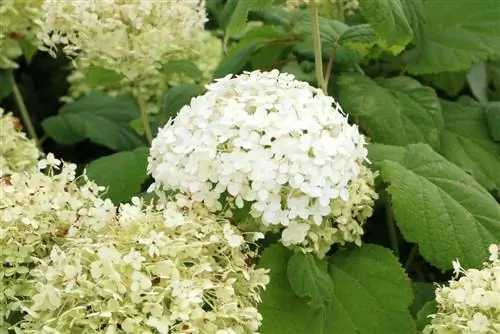
The particularly large flowers of the Annabelle hydrangea look magnificent, but there is a risk that the plant will break under the heavy flowers. If the inflorescences sink slightly towards the ground over time, this is generally not a problem for the shrub. However, if you want to make sure that the viburnum hydrangea does not bend over, you should support it as soon as the flowers become significantly larger. The following utensils are suitable for this:
- Stand support
- Bamboo sticks
- Grid
Fertilize
The nutrient requirements of the viburnum hydrangea are moderate, but the decorative plant also enjoys occasional fertilizer. Organic fertilizers such as mature compost, manure or horn shavings are particularly suitable for this. These also have the advantage that they break down in the soil over time and over-fertilization is therefore hardly possible. A hydrangea fertilizer that emphasizes potassium and magnesium is also suitable, but is usually a little higher in price. Alternatively, a fertilizer for azaleas or rhododendrons can also be used. When fertilizing snowball hydrangeas, it is important to note the following:
- Fertilize with organic complex fertilizer from spring to July
- Administer hydrangea fertilizer every 4 weeks between April and October
- do not fertilize more often, otherwise the plant will form soft shoots
- these cannot support the heavy inflorescences
- Do not use blue grain because it contains too much nitrogen
- Avoid garden compost, as it is usually very calcareous
If the viburnum hydrangea is grown in a pot, it usually has a higher nutrient requirement, which is why it needs to be fertilized more often. A liquid hydrangea fertilizer is suitable for this, which is administered once a week in spring and summer.
Pouring
The viburnum hydrangea has a fairly high water requirement, requiring around 10 liters of water per day. Accordingly, it should be watered regularly, although freshly planted hydrangeas in particular should be kept moist in the first few weeks. The Annabelle hydrangea does not necessarily need to be watered with rainwater because it also tolerates drinking water very well. The decorative plant is best watered as follows:
- always keep moist
- water when the soil surface is still slightly moist
- Watering roots directly
- water in the morning and evening in summer
- However, avoid waterlogging!
Tip:
If you water the viburnum hydrangea with tap water, you should definitely pay attention to the hardness of the water. If the hardness is above 14° dH, it is advisable to descale the water before watering. To do this, the water is poured into a container and a bag filled with peat is hung inside. If the water is left overnight, it will be softer the following day.
Repotting
As soon as the viburnum hydrangea outgrows its container and its roots no longer have enough space, it should be repotted. The diameter of the new container should be at least 5 centimeters larger than the previous one so that there is enough space for the roots. The bottom of the container is first covered with pebbles or clay granules before the plant is repotted as follows:
- fill new container one third with soil
- Tilt the hydrangea and remove the old container
- carefully remove used soil
- make sure that the root ball is not damaged
- remove part of the root mass if necessary
- use a sharp cutting tool for this
- Place the hydrangea in the middle of the new container
- Fill the container with soil and press it lightly
- pour in immediately
- Soil should be moist but not wet
Tip:
Although the plant can be planted and repotted all year round, the best time for this work is spring.
Cutting
The Annabelle hydrangea is cut either in winter, spring or autumn. The plant produces its flowers on annual wood, which is why new growth can be expected as early as March. The choice of the right time also depends on the weather conditions, as the cut should definitely take place on a frost-free day. However, how far the snowball hydrangea is cut back is up to the taste of the hobby gardener. Although it can tolerate a radical cut back to around 15 centimeters above the ground, it does not necessarily require it. However, radical pruning promotes new growth because it gives the plant more strength to do so. Pruning the snowball hydrangea is as follows:
- cut back to about 15 cm above the ground
- However, one pair of eyes should remain on the shoot
- This makes the hydrangea grow particularly vigorously
- and forms large inflorescences
- remove thin and dead shoots
Tip:
Do not remove the withered inflorescences, as these serve as natural winter protection for the plant.
Light pruning
If the snowball hydrangea is in a windy location that is not protected from rain, radical pruning is not recommended. The new shoots are usually not very stable, which can cause the plant to let its flower heads hang, especially after heavy rainfall. In such cases, it is better to only prune the viburnum hydrangea lightly. This has the disadvantage that the flowers don't grow as big, but the branch structure is more stable and the plant doesn't break as easily.
Wintering
The snowball hydrangea is considered to be completely hardy and can easily survive temperatures down to -25 degrees. However, it is advisable to protect newly planted hydrangeas from frost in the first year. A cover made of burlap offers the young plants sufficient protection from frustration when it is placed over them. If the winter is particularly windy and there is little snow, it is advisable to additionally protect the roots of the snowball hydrangea. For this purpose, for example, a thick layer of straw, brushwood or leaves can be spread around the plants. When growing in a bucket, however, frost protection is essential, otherwise there is a risk that the planter will freeze completely. The following measures protect the plants in the winter months:
- Put a jute bag over the plant
- Place the bucket on a wooden or polystyrene plate
- position in a place protected from the wind
- alternatively bring the plant into the house
- Location should be as cool as possible
- temperatures of 16-18 degrees are optimal
Tip:
The viburnum hydrangea must never dry out, regardless of whether it is grown outdoors or in a pot. It is therefore essential that it is always watered, even in the winter months.
Propagate
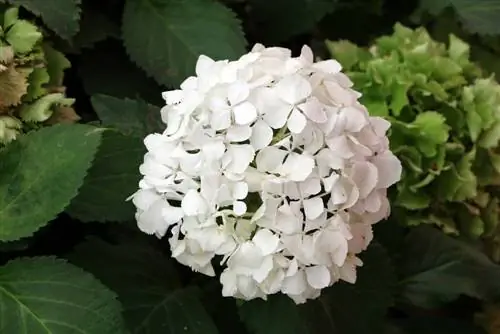
The propagation of the snowball hydrangea can be done both by cuttings and by planting. If you want to propagate your plant through cuttings, first choose a strong one and cut it back to around 15-20 centimeters. It is important that there are at least two eyes on the shoot. Once the appropriate cutting has been chosen, proceed as follows:
- cut off the bottom end diagonally
- cut the top end straight
- Place half of the cutting in potting soil
- Keep soil moist at all times
- place in a shady place
- after a short time the cutting will already form roots
- and can be planted
Propagation by lowering plants takes place best in the summer months. First, a groove is dug into the ground with a spade. A shoot that is as little woody as possible is then selected and lightly scratched in two to three places. Now the sinker is pulled to the ground and covered with earth, although the end of the shoot should still be visible. If necessary, the lowering device can also be weighted with stones so that it does not ring back upwards. As soon as the shoot has formed its own root system, it is cut off from the mother plant and planted in its new location.
Diseases and pests
One of the few diseases that could affect the viburnum hydrangea is powdery mildew. This is a stubborn fungal infection that is promoted by dryness. If the plant is infected, the affected parts of the plant must be cut off immediately and disposed of with residual waste. However, powdery mildew can be prevented by watering the plants in the early morning hours and by keeping enough distance from their neighbors. The snowball hydrangea is also often attacked by the following pests:
- Aphids
- Ants
- scale scale insects
- Weevil
The aphids in particular like the viburnum hydrangea and at the same time attract the annoying ants. The pests can be eliminated by setting up sticky traps with pheromones. In addition, spreading nettle manure has proven effective as a remedy against aphids. Instead of nettle manure, milk water is also suitable, which is mixed in a ratio of 1 liter of water to 0.5 liters of milk and then sprayed.
Care errors
The viburnum hydrangea is considered to be particularly robust against diseases, but any care errors become noticeable relatively quickly. If the plant lets its leaves droop, this is usually a sign of a lack of water. In such cases it should be watered immediately. If the leaves turn yellow, this is usually due to a soil pH that is too high, waterlogging or a lack of iron. If the pH value is too high, humus should be added to the soil.

